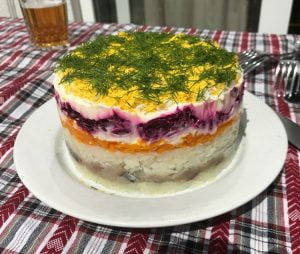Various recipes explored for this classic Russian dish, together with a photograph of one I made earlier
HERRING UNDER A FUR COAT

The Russian taste for mayonnaise in salads achieves its greatest glory in this, the fanciest salted herring dish ever – and one of the tastiest. There are variations on the ingredients and arrangement of this classic Russian dish, also known simply as Shuba (fur coat).
4 salted herring fillets:
Recipes generally recommend 4 fillets, sometimes fewer; some specify preserved in oil, some don’t but add oil as a separate ingredient, some don’t mention oil at all. Salt herring in oil makes sense, but to achieve solidity, I’d remove most of it from the fillets.
1 onion:
White, yellow or red are specified. Some suggest boiling sharper-tasting varieties for a minute or two to soften the flavour. It makes sense to go with personal preferences on raw onion, but for the contrast with the other softer flavours, I’d err towards a definite bite.
2 medium potatoes:
Most just say potatoes, some specify Yukon gold, a variety halfway between waxy and floury with a buttery flavour.
2 medium carrots:
Most peel and boil these with the potatoes, some peel them after boiling. Some suggest fresh grated carrot, patted dry to get rid of the moisture. The origin of the recipe probably post-dates the 1860s development of the chopped vegetable Russian salad, so boiled may be more authentic.
2 beetroots:
Most suggest boiling the beetroots until tender. One suggests achieving this end by baking them in foil. Baking in foil preserves more flavour.
Mayonnaise:
The suggestions tend to vary between 200ml and 350ml, but see also below.
2 boiled eggs
Dill to garnish
One recipe ups it to 3 large potatoes, 3 large beetroots, 2 large carrots, but suggests only 1/2 an onion and to use less if you prefer. This seems like a smothering of the essential contrasts, but each to their own.
The ingredients need to be prepared separately beforehand and then assembled. Some go for doing this in a ring or even a spring-form mould, which is then removed to reveal the layers. Some just layer on a plate.
Chop the herring – some suggest a fine chop, some a 1cm dice. Finely dice the onion. Most grate the potatoes and carrots, some finely dice them. The beetroot should be grated. The boiled egg whites and yokes should be separated and finely grated. The dill should be chopped, although it isn’t always used.
You can start with the herring as the first layer, followed by the onion or use half the potato as the first layer, topped with the herring, then the onion. After the onion add a layer (or further layer) of potato, then the carrot, then the beetroot.
Some mix the beetroot with the mayonnaise before creating this layer, some add the mayonnaise as a separate layer, allowing the beetroot to colour the mayonnaise from below. The mayonnaise is topped with the grated egg whites, then the egg yolks and then the dill.
The beautifully-produced CCCP Cook Book describes the emergence of serious up-mayonnaising in the 1960s – East and West it was the decade of mayonnaise. The onion layer after the original herring one is covered with plenty of mayonnaise, then lattices of mayonnaise cover both the potatoes and the carrots.
The layers should not be pressed down, but the dish should be refrigerated for at least 6 hours, preferably overnight. It should be possible to cut slices of the salad, maintaining the integrity of the layers. Variously, the beetroot and mayonnaise, or the egg (with or without the dill) are supposed to suggest the fur coat.
This is a truly great dish, culturally claimed and venerated in Russia and in both Jewish and non-Jewish Russian diasporas. For something that is not hugely difficult to make, the look and the taste of it get you all kinds of bonus points when you bring it to the table. Trust me. If you’ve never tried making it before, you’ll thank the herripedia for this one.
